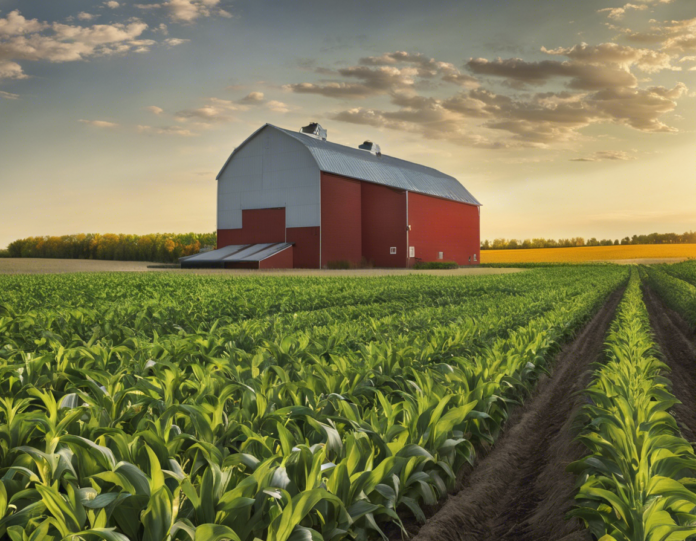Introduction:
When it comes to farming in Ontario, Canada, there are a wide variety of crops that farmers can choose to cultivate. Ontario’s diverse climate and fertile soil make it an ideal location for growing a range of crops, from grains and oilseeds to fruits and vegetables. In this comprehensive guide, we will explore some of the best crops for farmers in Ontario, taking into account factors such as market demand, profitability, and suitability for the region’s growing conditions.
Grains and Oilseeds:
Grains and oilseeds are staple crops in Ontario, with wheat, corn, and soybeans being among the top crops grown in the province. These crops are in high demand both domestically and internationally, making them lucrative options for farmers.
1. Wheat:
Wheat is a major crop in Ontario, with both winter and spring wheat varieties being cultivated in the region. Winter wheat is usually planted in the fall and harvested the following summer, while spring wheat is planted in the spring and harvested in the late summer or early fall. Wheat is used for a variety of products, including flour for baking and feed for livestock.
2. Corn:
Corn is another important crop in Ontario, with the province being one of the largest corn-producing regions in Canada. Corn is used for food products, animal feed, and ethanol production. The high demand for corn makes it a profitable crop for farmers, especially when managed with sustainable practices.
3. Soybeans:
Soybeans are a versatile crop that can be used for a variety of products, including soybean oil, soy flour, and soy protein. Ontario is a major producer of soybeans, with many farmers incorporating soybeans into their crop rotation to improve soil health and reduce pests.
Fruits and Vegetables:
Ontario’s mild climate and fertile soil make it an ideal location for growing a wide variety of fruits and vegetables. From berries and apples to sweet corn and tomatoes, there are numerous options for farmers looking to diversify their crops.
4. Apples:
Apples are a popular fruit in Ontario, with many different varieties being grown in the province. Ontario is known for its high-quality apples, which are enjoyed fresh or used in a variety of processed products such as applesauce and cider.
5. Berries:
Berries such as strawberries, blueberries, and raspberries thrive in Ontario’s climate, making them profitable crops for farmers. Berries are in high demand due to their health benefits and versatility in culinary applications.
6. Sweet Corn:
Sweet corn is a popular vegetable in Ontario, with consumers enjoying it fresh, frozen, or canned. Ontario farmers can capitalize on the summer demand for sweet corn by planting multiple successions throughout the season.
Specialty Crops:
In addition to traditional crops like grains and fruits, Ontario farmers can also explore cultivating specialty crops that cater to niche markets and fetch premium prices.
7. Ginseng:
Ginseng is a high-value crop that thrives in Ontario’s climate and soil conditions. Ontario is one of the leading producers of North American ginseng, with the majority of the crop being exported to Asian markets where it is highly prized for its medicinal properties.
8. Lavender:
Lavender is a niche crop that is gaining popularity in Ontario due to its aromatic and therapeutic properties. Lavender farms can attract tourists looking to experience the beauty and fragrance of the purple fields, making it a potentially profitable venture for farmers.
9. Hemp:
Hemp cultivation is on the rise in Ontario, with farmers tapping into the growing demand for hemp-derived products such as CBD oil, hemp fiber, and hemp seeds. Hemp is a resilient crop that requires minimal inputs, making it an attractive option for sustainability-minded farmers.
Market Gardening:
For farmers looking to cultivate a diverse range of crops on a smaller scale, market gardening offers an opportunity to grow high-value produce for direct sale to consumers.
10. Tomatoes:
Tomatoes are a popular crop for market gardeners in Ontario, with heirloom varieties being especially sought after for their unique flavors and colors. Tomatoes can be sold fresh, canned, or used to make value-added products like salsa and pasta sauce.
11. Microgreens:
Microgreens are young, tender greens that are harvested soon after germination and are packed with nutrients and flavor. Microgreens are a popular choice for market gardeners looking to cater to health-conscious consumers and chefs seeking to enhance their culinary creations.
Sustainable Agriculture Practices:
Incorporating sustainable agriculture practices is essential for the long-term success and viability of farming operations in Ontario. Farmers can adopt practices such as crop rotation, cover cropping, and integrated pest management to improve soil health, reduce environmental impact, and enhance crop resilience.
Crop Rotation:
Crop rotation involves planting different crops in succession on the same piece of land to improve soil fertility, reduce pests and diseases, and break weed cycles. Farmers in Ontario can benefit from rotating grains, oilseeds, and vegetables to optimize yields and minimize inputs.
Cover Cropping:
Cover cropping involves planting non-harvested crops such as legumes and grasses to protect and improve soil health during periods when the main cash crops are not growing. Cover crops help prevent erosion, suppress weeds, and enhance nutrient cycling in Ontario’s agricultural landscapes.
Integrated Pest Management (IPM):
Integrated pest management (IPM) is a holistic approach to managing pests by combining biological, cultural, physical, and chemical control methods. Farmers in Ontario can implement IPM strategies to minimize pesticide use, conserve beneficial insects, and promote pest resistance management.
Conclusion:
In conclusion, Ontario offers a wealth of opportunities for farmers to cultivate a diverse range of crops, from staple grains and fruits to specialty crops and market garden produce. By selecting the best crops that align with market demand, profitability, and growing conditions, farmers can optimize their agricultural operations and contribute to the vibrant agricultural sector in Ontario.
FAQs:
-
What are the most profitable crops to grow in Ontario?
Wheat, corn, soybeans, apples, and ginseng are among the most profitable crops for farmers in Ontario due to high demand and market prices. -
How can farmers diversify their crop selection in Ontario?
Farmers can diversify their crop selection by exploring specialty crops like lavender and hemp, as well as market gardening options such as tomatoes and microgreens. -
What sustainable agriculture practices are recommended for Ontario farmers?
Crop rotation, cover cropping, and integrated pest management are sustainable agriculture practices that Ontario farmers can adopt to improve soil health and reduce environmental impact. -
Are there any grants or subsidies available for Ontario farmers to support crop diversification?
Yes, various government programs and agricultural organizations in Ontario offer grants and subsidies to support farmers in diversifying their crops and adopting sustainable practices. -
What are some key considerations for farmers looking to transition to organic crop production in Ontario?
Farmers looking to transition to organic crop production in Ontario should consider factors such as certification requirements, marketing opportunities, and crop rotation plans to ensure a successful transition to organic farming methods. -
Which crops are well-suited for organic production in Ontario?
Crops such as organic grains, fruits, and vegetables, as well as specialty crops like organic ginseng and lavender, are well-suited for organic production in Ontario due to consumer demand for organic products. -
How can farmers in Ontario access market information and trends to inform their crop selection decisions?
Farmers in Ontario can access market information and trends through agricultural publications, industry associations, government reports, and online resources to stay informed about consumer preferences and market opportunities for different crops. -
What are some key challenges that farmers may face when growing specialty crops in Ontario?
Challenges that farmers may face when growing specialty crops in Ontario include market volatility, labor-intensive cultivation practices, niche market competition, and ensuring product quality and consistency to meet consumer expectations. -
What resources and support are available for Ontario farmers interested in exploring new crop varieties and production techniques?
Ontario farmers can access resources and support through agricultural extension services, research institutions, government agencies, and industry networks to learn about new crop varieties, production techniques, and best practices for crop cultivation. -
How can farmers in Ontario mitigate risks associated with climate change and extreme weather events when planning their crop selection?
Farmers in Ontario can mitigate risks associated with climate change and extreme weather events by diversifying their crop portfolio, investing in on-farm infrastructure like irrigation systems and crop protection measures, and staying informed about weather forecasts and agroclimatic trends to make timely decisions for crop management.









